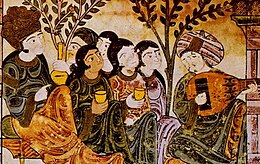Arab Muslims
| Part of a series on |
| Arabic culture |
|---|
 |

Arab Muslims (Arabic: مسلمون عرب) are adherents of Islam who identify linguistically, culturally, and genealogically as Arabs. Arab Muslims greatly outnumber other ethnoreligious groups in the Middle East. Arab Muslims comprise a majority of the population in Algeria, Bahrain, Egypt, Iraq, Jordan, the Palestinian territories, Oman, Qatar, Saudi Arabia, Syria, the United Arab Emirates, Tunisia, and Yemen. Libya, Tunisia, Algeria and Morocco are mistakenly considered Arab-only countries, whereas they also contain Amazigh, natives of those countries. [1] Not all citizens of Arab-Muslim majority countries identify as Arab Muslims; many Arabs are non-Muslim and many Muslims are of non-Arab ethnicity. Arab Muslims form the largest ethnic group among Muslims in the world,[2] followed by Bengalis,[3] Punjabis,[4] and Javanese.
Some citizens of Egypt and Lebanon identify as Egyptian and Lebanese more so than they identify as Arab or Muslim.[5]
A substantial number of Arab Muslims live in the Arab diaspora. Arab Muslims comprise the majority of the Arab populations in Belgium, France, Germany, Indonesia, Iran, Israel, the Netherlands, Turkey, and the United Kingdom, while Arab Christians are the majority of the Arab populations in Argentina, Australia, Brazil, Chile, Colombia, Cuba, Greece, Haiti, Mexico, the United States, Uruguay, and Venezuela. Around a quarter of Arab Americans identify as Arab Muslims.[6]
See also[]
- Arab Christians
- Arab Jews
- Druze
- Ishmaelites
- Bahai
References[]
- ^ Peter Haggett (2001). Encyclopedia of World Geography. 1. Marshall Cavendish. p. 2122. ISBN 0-7614-7289-4.
- ^ Margaret Kleffner Nydell Understanding Arabs: A Guide For Modern Times, Intercultural Press, 2005, ISBN 1931930252, page xxiii, 14
- ^ roughly 152 million Bengali Muslims in Bangladesh and 36.4 million Bengali Muslims in the Republic of India (CIA Factbook 2014 estimates, numbers subject to rapid population growth); about 10 million Bangladeshis in the Middle East, 1 million Bengalis in Pakistan, 5 million British Bangladeshi.
- ^ Gandhi, Rajmohan (2013). Punjab: A History from Aurangzeb to Mountbatten. New Delhi, India, Urbana, Illinois: Aleph Book Company. p. 1. ISBN 978-93-83064-41-0.
- ^ "A Growing Muslim Identity". Brookings Institution. Retrieved 2020-08-22.
- ^ "Arab Americans: Demographics". Arab American Institute. 2006. Archived from the original on 1 June 2006. Retrieved 22 August 2020.
Bibliography[]
- Ankerl, Guy (2000). Coexisting Contemporary Civilizations: Arabo-Muslim, Bharati, Chinese, and Western. Geneva: INU Press. ISBN 2-88155-004-5.
- Arab Muslims